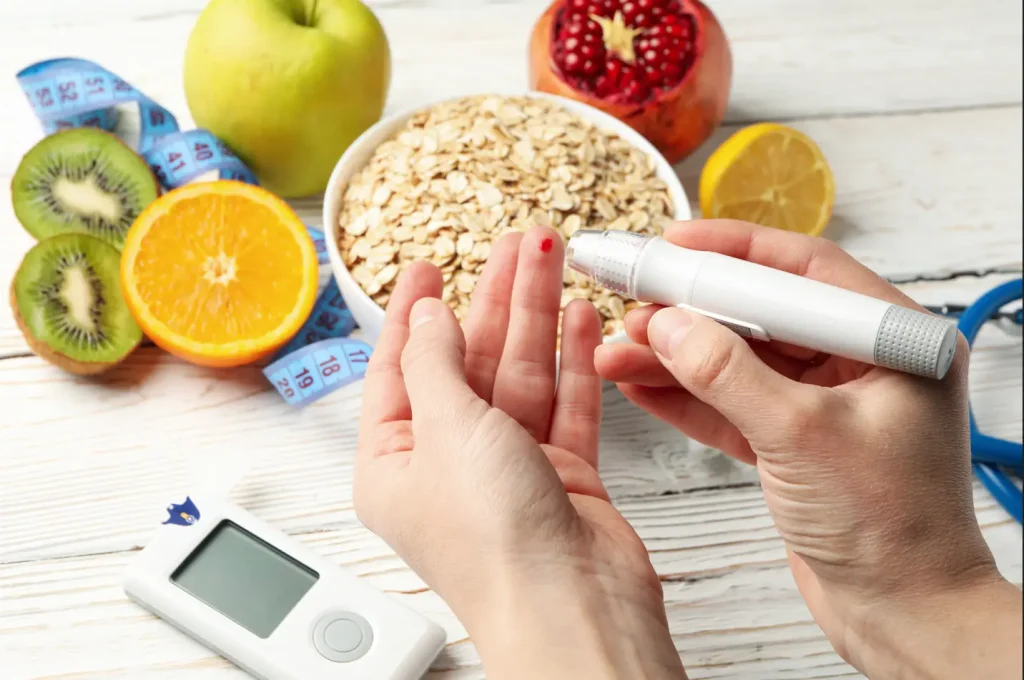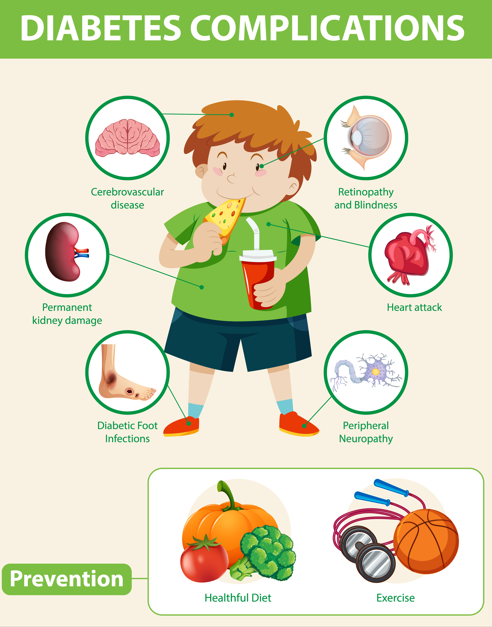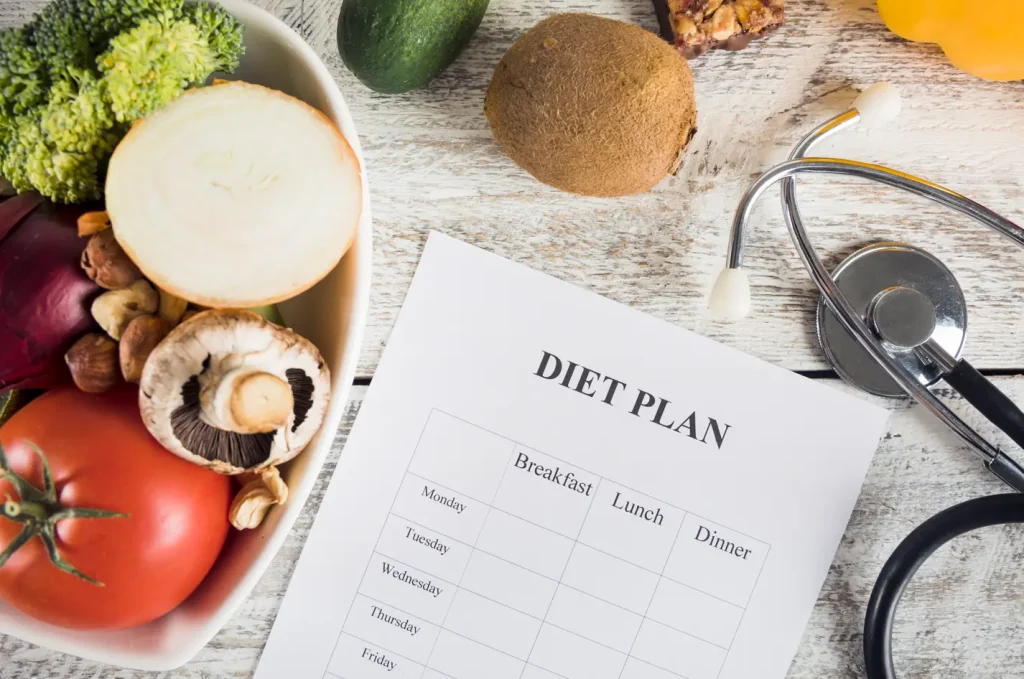
It is not a smooth life for a diabetic, but it can be managed with intelligent food choices and exercises to reduce complications.. Moreover, monitoring what you have on your plate and how you stick to your exercise regime is crucial, as it helps keep your blood sugar stable. This guide explains how diabetic food charts work together for diabetic patients, as well as diet and exercise, so you can help manage diabetes effectively and directly.
What is a Diabetic Food Chart?
A diabetic food chart is a planned food guide that helps diabetic individuals manage their blood sugar levels by showing them what, when, and how to eat. It is an essential part of diabetes management, medicine and regular exercise.
Managing Diabetes effectively is not about quick reforms, but about permanent habits.
How To Plan A Sugar Patient’s Diet Chart
The food you consume is the primary tool for controlling your blood sugar. This is not about cutting out food but about choosing intelligent options.
1. Balanced food is essential
Mix carbs, protein and healthy fats in every meal. It slows down the speed at which sugar enters the blood, preventing those annoying spikes.
- For example, besides one bowl of pasta, include grilled chicken and steamed broccoli.
- Complete foods: whole grains (quinoa, oats), fresh fruits, fresh vegetables, legumes (beans, lentils).
- Protein and fibre help to keep things stable.
2. Controlling Portions
Excess of anything is bad; even excessive healthy foods may spike sugar.
Pay attention to serving sizes:
- The Diabetes plate method is the best non-count way to eat good food
- Half plate: Include vegetables with no starch, such as spinach, broccoli, and chilli.
- Quarter plate: Take lean protein, chicken, fish, and beans.
- Quarter plate: Carbohydrates, whole grains, veggies.
3. Fibre is Essential
The fibre in most fruits, vegetables and whole grains acts as a sponge, slowing down sugar absorption, which means more stable blood sugar.
A sugar patient diet chart includes apples, berries, leafy greens, oats, brown rice, and lentils.
4. Exclude The Negatives
- Sugar beverages and sweets rapidly cause blood sugar spikes and provide little nutrition. Therefore, avoid drinking soda-laced drinks and choose water options.
- Exclude cookies, chips, sugar grains, and processed meats. These are quick ways to blood sugar roller coasters.
- Fried foods and unhealthy fats contribute to weight gain and can damage your heart.
5. Embrace “Superfoods” for diabetes
- Other heart-friendly foods: Include salmon, avocado, nuts, seeds and olive oil, which must be consumed in a limited amount every day for health purposes
- Whole grains: Avoid white rice or flour and eat quinoa, oats, and legumes such as beans and lentils, which are full of vitamins.
- Vegetables: Pick up broccoli, spinach, cucumbers, mushrooms, and peppers.
- Say yes to Lean Proteins, such as chicken (skinless), turkey, fish, black beans, and black-eyed peas.
- Constant food time: Eating around the same time each day helps your body to regulate blood sugar more smoothly.
What Is Diabetes Management?

It is a balanced treatment consisting of diet, exercise and sometimes medicines. To avoid severe complications from diabetes, keep your blood sugar levels reasonable most of the time through exercise and medicine.
1. Diabetes management in daily life
- Poor diet: Too much sugar and processed food can cause blood sugar spikes.
- Lack of exercise: Weight increases, making your body less responsive to insulin.
- Stress: Increases blood sugar. Find healthy ways to manage stress.
- Smoking: Harms the blood vessels and increases insulin resistance.
- Additional alcohol: It increases or reduces blood sugar levels and can negatively affect your pancreas.
- Poor sleep: Lack of quality sleep can also make your body sensitive to insulin. Priority is 7-9 hours of sleep.
2. Diabetes Exercise: Your body’s natural insulin booster
Physical activity is potent. This helps your body use insulin more effectively and can directly reduce blood sugar levels.
Aerobic exercise (cardio)
- Activities like fast walking, jogging, cycling, or swimming are excellent for your heart and improve your body’s reaction to insulin.
Strength training
- Use muscle training to absorb glucose efficiently.
- Include exercise using weights, a resistance band, or even your body weight (push-ups, squats).
- Do power training two or more days a week.
Make it a habit
It is more important to find out the activities you enjoy!
- Easy win: Take the stairs, park forward, do the chair yoga if you are homebound. Even stretching or arm/leg rise count!
- Monitor your blood sugar around the workout:
Check your blood sugar before and after exercise. This helps you understand how different activities affect you and allows you to adjust snacks or medicine.
3. Medicine: When you need an additional hand
For many people, medicine is an essential part of diabetes management. It works with diet and exercise to keep blood sugar levels stable.
- As prescribed: Always follow your doctor’s drug dose and time instructions.
- Check-up: Visit your diabetician to monitor how well your medicine works and start adjusting if necessary.
- Side effects: You should learn about potential side effects and discuss any concerns with your healthcare provider.
- Medication and Lifestyle: Medicines work best with healthy food and regular physical activity.
What to Include in Your Indian Diabetes Diet
Managing diabetes with an Indian diet is delicious and effective. This meal scheme includes traditional Indian recipes, keeping the blood sugar level in mind. It is about enjoying all controlled carbohydrates, healthy fats, and balanced foods with lots of protein while focusing on nutritious foods.
Whole grains:
- Chapati/Roti: Whole wheat, Jovar, Millet, or Ragi.
- Avoid white rice and include brown rice.
- Quinoa: An excellent protein-rich grain.
- Millets: Jovar, millet, ragi, and FoxTel millet are highly recommended for fibre content.
Vegetables:
- Spinach, cauliflower, capsicums, bitter gourd, bottle gourd, brinjal, cabbage, ladyfingers and broccoli.
- Starch in moderation: Potatoes, sweet potatoes, green peas.
Protein Source:
- Lentils and Beans: All Indian pulses, Rajma (Kidney Beans), and Chola.
- Paneer: Choose low-fat options.
- Tofu: A great plant-based option.
- Lean meat/fish: Skinless chicken, freshwater fish.
- Good fats: almonds, walnuts, chia, sunflower, and pumpkin seeds, olive oil, and peanut oil.
- Fruits: Strawberry, blueberry, jamun, apple, guava, orange, pomegranate.
What Not To Have In An Indian Diet Chart for A Diabetic Patient
To keep your blood sugar in check and support overall health, it is essential to know what to exclude:
Refined grains:
- Take brown rice, millet or quinoa.
- Avoid white bread and choose the wheat or multigrain option.
- Avoid processed flour products.
Sweet food:
- Pastry, Candies: Avoid Indian sweets like Gulab Jamun, Jalebi and Laddu.
- Sugared juices: These increase blood sugar. Take more water, drink tea, or take fresh lime juice.
- Sweet snacks: Many packaged snacks contain hidden sugars.
High-fat dairy:
- Full-fat milk, cheese, and cream: Opt for skimmed and low-fat milk and cream.
Deep-fried snacks and curry: Limit the dishes that involve a lot of deep frying.
Excessive salt: Avoiding pickles controls sodium intake.
Processed meat and canned soup: Often, there are excessive amounts of salt and preservatives.
Restaurant meal: Avoid the high salt content in many restaurant dishes.
7-Day Indian Diet Plan for Diabetes Patients

Adjust portions according to individual caloric and dietary needs, activity levels, and medical advice.
Day 1: Monday
- In the morning (7:00 am): 1 glass of fenugreek water (soaked overnight)
- Breakfast (8:00 pm): Sambar (a lot of vegetables, no sugar) and a small part of coconut chutney (low oil).
- Mid-morning (11:00 am): 1 small apple.
- Lunch (1:00 pm): 2 small whole wheat rotis, 1 cup mixed vegetables (eg, green beans and carrots), 1 cup dal (moong or lentils), small bowl of cucumber salad.
- Evening Snack (4:30 pm): A handful of roasted gram (chickpeas).
- Dinner (8:00 pm): Chicken, vegetable clear soup, one bowl, brown rice pulao with mixed vegetables (less oil, no potatoes), one cup.
Day 2: Tuesday
- In the morning (7:00 am): Bitter gourd thin juice, one small cup
- Breakfast (8:00 pm): 1 bowl of vegetables (made with broken wheat/porridge, a lot of vegetables like peas, carrots, beans).
- Middle-morning (11:00 am): One guava.
- Lunch (1:00 pm): A bowl of brown rice, fish curry cooked in low oil and coconut milk, and one cup of Beetroot stir fry.
- Evening Snack (4:30 pm): One cup of chhach or buttermilk.
- Dinner (8:00 PM): 2 small jovar rotis, 1 cup cheese, spinach (low oil), small bowl of tomato and onion salad.
Day 3: Wednesday
- Morning (7:00 am): One glass of carom seeds juice.
- Breakfast (8:00 am): 2 small gram flour pancakes with mint chutney
- Mid-morning (11:00 am): 1 small orange.
- Lunch (1:00 pm): 2 small whole wheat rotis, 1 cup mixed vegetables (e.g., gourd and ridge gourd), 1 cup chana dal, and a small bowl of radish salad.
- Evening snack (4:30 pm): A Few roasted almonds.
- Dinner (8:00 pm): Mixed vegetable porridge, one cup.
Day 4: Thursday
- Morning (7:00 am): 1 glass of amla (Indian Gozberry) juice (thin).
- Breakfast (8:00 am): 1 bowl of oat porridge with vegetables or plain with a pinch of salt.
- Mid-morning (11:00 am): 1 small pear.
- Lunch (1:00 pm): 1 cup quinoa casserole with mixed vegetables and a small part of lean chicken breast.
- Evening (4:30 pm): 1 hard-boiled egg.
- Dinner (8:00 pm): Two millet chapatis, a cup of bottle gourd, and one cup lentil dal.
Day 5: Friday
- Middle-morning (11:00 AM): Small bowl of mixed berries (strawberries, blueberries). Lunch (1:00 pm): 2 small whole wheat rotis, 1 cup of cabbage and peas, 1 cup rajma (kidney beans curry, low oil), small bowl of carrot salad.
- Evening snack (4:30 pm): A handful of roasted pumpkin seeds.
- Dinner (8:00 pm): 1 bowl mixed vegetable soup, 1 cup chicken mince with green peas (low oil).
Day 6: Saturday
- Morning (7:00 am): 1 glass bitter gourd juice (small amount, thin).
- Breakfast (8:00 am): 2 small moong dal chila with green chutney (pancakes made of lentils).
- Mid-morning (11:00 am): 1 small peach.
- Lunch (1:00 p.m.): 1 cup brown rice, 1 cup mixed vegetable curry (non-starchy vegetables such as cauliflower and capsicum), and 1 cup soya chunk.
- Evening Snack (4:30 pm): Rusk biscuits with Green tea.
- Dinner (8:00 pm): Two small multi-grain rotis, one cup of ladyfinger vegetable (Okra), and fresh cucumber and tomato with plain yoghurt.
Day 7: Sunday
- In the morning (7:00 am): 1 glass of water with carom seeds.
- Breakfast (8:00 am): 1 bowl of flat rice (no potato, minimum oil).
- Mid-morning (11:00 am): 1 small pear.
- Lunch (1:00 pm): 2 small whole wheat rotis, 1 cup of mixed veggies (broccoli, vine chilli, mushrooms), 1 cup black chickpeas.
- Evening Snack (4:30 pm): A small bowl of plain curd with black salt water splashes. Dinner (8:00 pm): Vegetable soup, a bowl, grilled cottage cheese, fish, and a cup of boiled vegetables.
Customisation: Your requirements will depend on your blood sugar levels, drugs, activity levels and other health conditions.
Cooking methods: Boiling, baking, grilling, steaming, stirring, select methods that use less oil and keep the nutrients intact.
Essential Ideas for a Diet Chart for Diabetic Patients
- Personal advice: Consult your doctor or a registered dietitian specialising in Indian diets. They can tailor a plan that suits your blood sugar levels, drugs, activity levels, and preferences.
- Spice It: Indian cooking uses many spices. Turmeric, fenugreek, cinnamon and ginger are known for their potential benefits.
- Take Cues from Your body: Check your blood sugar regularly. Watch how different foods affect you..
- Be active: Remember, diet and exercise are a team effort. Include regular physical activity to help manage blood sugar and promote overall health.
Conclusion
Living enjoyably and controlling diabetes may not be easy, but it is possible. You can achieve a healthy lifestyle with a diabetic diet chart, diligent physical activity, and taking prescribed drugs. These three elements do not work in isolation; they work best together.
Keep communication channels with your doctor open, especially before experimenting with any new diet or exercising routine, and for personal advice on your diabetes management plan. KARE Prosthetics & Orthotics India clinicians are dedicated to offering patients the best care and medical advice and helping them heal to lead better lives. Diabetes management combines correct medication, physical therapy, accurate orthotics support and a planned diabetic food chart.
If you are a diabetic and confused about your dietary requirements, you can book a consultation today for expert advice. Call for appointments. Your good health is worth the effort!



